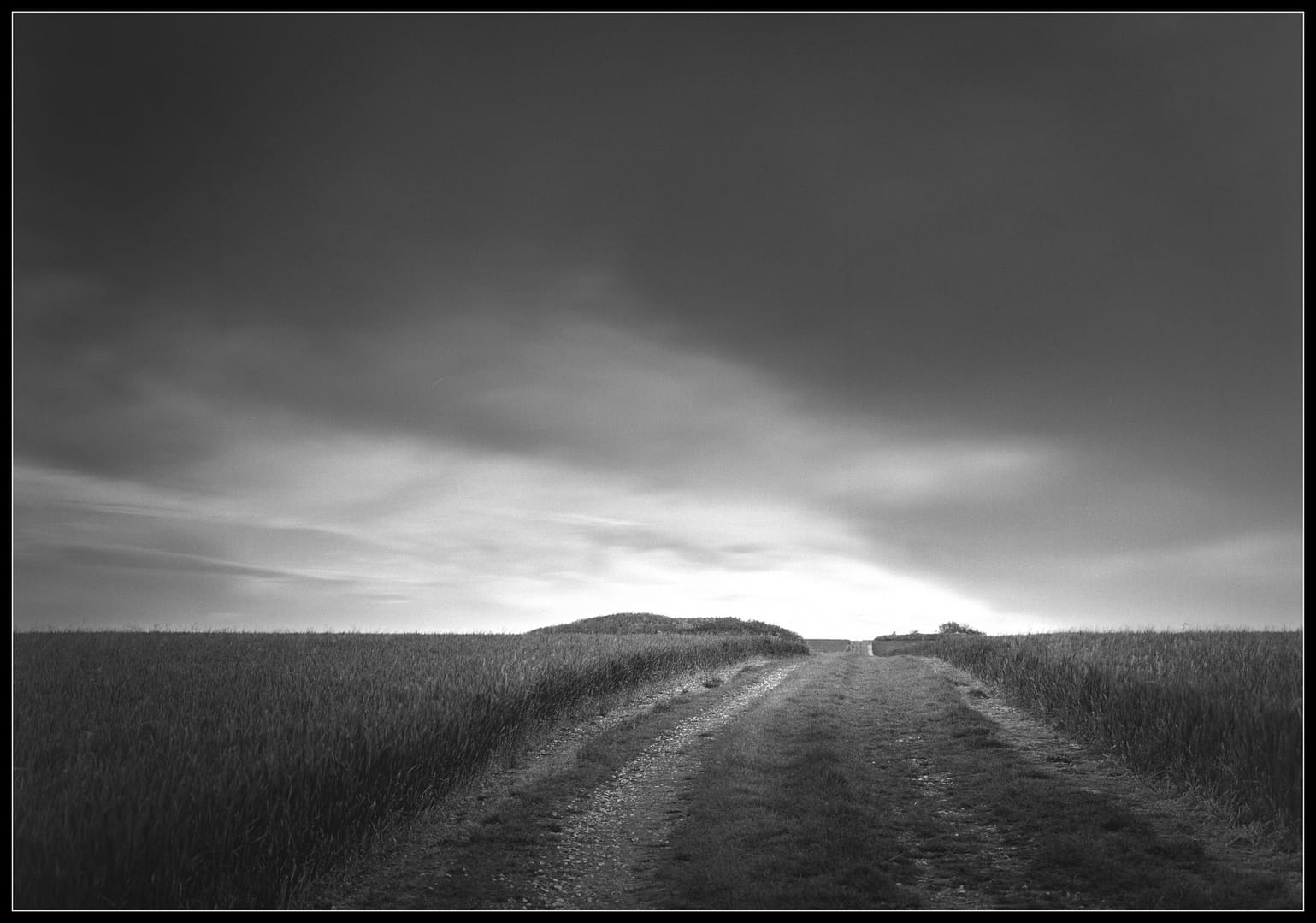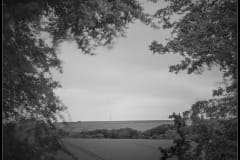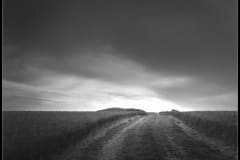Spring had finally settled in, and the warmth of the day hinted at the summer ahead. On a recent trip to Watership Down, I decided to bring along my trusty Bronica ETRSi, loaded with a roll of Ilford FP4+ film, to capture the enchanting landscape in black and white. Little did I know, the day would turn into a dramatic showcase of nature’s power and beauty.
Table of Contents
The Setting: Watership Down
Watership Down, a name familiar to many from Richard Adams’ classic novel, is a picturesque hill in Hampshire, England. Known for its rolling fields and stunning vistas, it’s a paradise for photographers. The late spring atmosphere was perfect, with lush greenery and wildflowers in full bloom.

The Sky Turns Dramatic
As the afternoon wore on, the skies began to change. Puffy white clouds gathered and darkened, hinting at a thunderstorm. The warm day gave way to a cooler breeze, and the air was charged with the anticipation of a storm. This transformation provided the perfect backdrop for my long-exposure shots.
The Gear: Bronica ETRSi and Ilford FP4+
For this outing, I chose my Bronica ETRSi, a medium format camera known for its incredible detail and tonal range. Paired with Ilford FP4+ film, known for its fine grain and high sharpness, it was the perfect combination to capture the dynamic range of the scene.
The Technique: Long Exposures
To capture the essence of the changing sky and the serene landscape, I opted for long exposures, ranging from 1:30 minutes to 5 minutes. This technique allowed me to smooth out the movement of the clouds and create a dreamy, ethereal quality in the images.
The Gallery
Reflections
This walk on Watership Down was not just about capturing beautiful images, but also about experiencing the subtle changes in nature. The use of black and white film added a timeless quality to the photos, emphasising the textures and contrasts in the landscape.
Photographing with film always adds a layer of anticipation and excitement, and this trip was no exception. The dramatic skies and the serene landscapes of Watership Down provided the perfect canvas for long exposures, and I’m thrilled with how these images turned out.
I hope you enjoy these glimpses into a late spring day on Watership Down, where the calm before the storm was captured in timeless black and white.
Feel free to share your thoughts and let me know which image resonates with you the most. Until next time, keep exploring and capturing the beauty around you!
Photography Tips: Mastering Medium Format Film and Long Exposure
Exploring the world of medium format film photography can be a rewarding and enriching experience. Whether you’re a seasoned photographer or just starting out, here are some tips to help you make the most of your medium format camera and achieve stunning long exposure shots.
Understanding Medium Format Cameras
- Choose the Right Film: Medium format film, like Ilford FP4+, offers higher resolution and finer grain compared to 35mm film. Research different film types to find one that suits your style and the lighting conditions you expect to encounter.
- Know Your Camera: Familiarise yourself with your medium format camera’s settings and features. Understanding how to manually adjust aperture, shutter speed, and focus will give you greater control over your shots.
- Metering for Accuracy: Use a handheld light meter for accurate exposure readings. Medium format cameras often require precise metering to achieve the best results, especially in varied lighting conditions.
- Stable Support: Use a sturdy tripod to prevent camera shake, essential for long exposure shots. Medium format cameras are heavier, and stability is crucial for sharp images.
Tips for Long Exposure Photography
- Select the Right Scene: Long exposures work best with scenes that include moving elements like clouds, water, or crowds. These create dynamic contrasts with the static parts of the image.
- Optimal Shutter Speeds: For long exposures, set your shutter speed to anywhere from a few seconds to several minutes. Experiment with different durations to achieve the desired effect.
- Use Neutral Density (ND) Filters: ND filters reduce the amount of light entering the lens, allowing for longer exposure times even in bright conditions. This is essential for capturing motion blur without overexposing the image.
- Cable Release or Timer: Use a cable release or the camera’s self-timer to start the exposure without touching the camera, minimising the risk of introducing shake.
- Calculate Exposure Adjustments: Long exposures often require compensating for reciprocity failure, a phenomenon where film sensitivity decreases with longer exposure times. Check your film’s specifications and adjust accordingly.
- Pre-Visualise Your Shot: Spend time composing your image and visualising the final result. Consider how the moving elements will appear blurred and how they will interact with the static parts of the scene.
- Check Your Frame: Medium format cameras typically have a waist-level viewfinder or a prism finder. Take your time to carefully frame your shot, ensuring all desired elements are within the composition.
Post-Processing Tips
- Developing Your Film: If you’re developing the film yourself, be meticulous with your process. Follow the recommended times and temperatures to ensure consistent results.
- Scanning Negatives: Invest in a high-quality scanner to digitise your negatives. This allows you to edit and share your photos while preserving the rich details captured by medium format film.
- Editing Software: Use photo editing software to make minor adjustments to contrast, brightness, and sharpness. Keep edits minimal to maintain the authentic look of film photography.
Embrace the Journey
Medium format film photography, combined with long exposure techniques, offers a unique and captivating way to capture the world. It requires patience, precision, and a bit of experimentation, but the results are often breathtaking. Embrace the process, learn from each shot, and enjoy the timeless quality of film photography. Happy shooting!
Environmental Note: Preserving the Beauty of Watership Down
The serene beauty of Watership Down is a reminder of the natural wonders that enrich our world. As photographers and nature enthusiasts, we have a responsibility to preserve these landscapes for future generations. Here’s why it’s important and how we can minimise our impact while visiting.
The Importance of Preservation
Natural landscapes like Watership Down are not just scenic vistas; they are vital ecosystems that support a diverse array of wildlife. These areas provide habitats for plants, animals, and insects, many of which are integral to the ecological balance. Preserving such places ensures that these species can thrive and that the natural beauty we cherish remains intact.
Additionally, natural landscapes offer invaluable benefits to humans, from recreational opportunities and aesthetic pleasure to mental and physical health benefits. By protecting these areas, we are also safeguarding these benefits for ourselves and future visitors.
How Visitors Can Minimise Their Impact
- Stay on Designated Paths: Stick to marked trails to avoid trampling vegetation and disturbing wildlife habitats. This helps prevent soil erosion and protects the integrity of the ecosystem.
- Leave No Trace: Carry out all trash and dispose of it properly. Avoid leaving any waste behind, as even biodegradable items can harm the environment and disrupt local wildlife.
- Respect Wildlife: Observe animals from a distance and do not feed them. Feeding wildlife can alter their natural behaviors and make them dependent on human food.
- Minimise Noise: Keep noise levels low to avoid disturbing the tranquility of the area and the creatures that inhabit it. Nature’s soundscape is part of its beauty.
- Use Eco-Friendly Products: When camping or picnicking, use biodegradable soaps and detergents. Avoid using plastic utensils and opt for reusable or biodegradable options.
- Educate and Advocate: Share your knowledge about the importance of preserving natural landscapes with others. Encourage fellow visitors to follow sustainable practices.
- Support Conservation Efforts: Consider donating to or volunteering with organisations dedicated to conserving natural landscapes. These efforts often rely on public support to continue their vital work.
- Responsible Photography: As photographers, be mindful of your surroundings. Avoid disrupting natural settings for the perfect shot, and be considerate of the impact your presence may have.
By taking these steps, we can ensure that Watership Down remains a pristine and inspiring place for future generations to enjoy. Let’s all do our part to protect these precious landscapes and the wildlife that calls them home.









